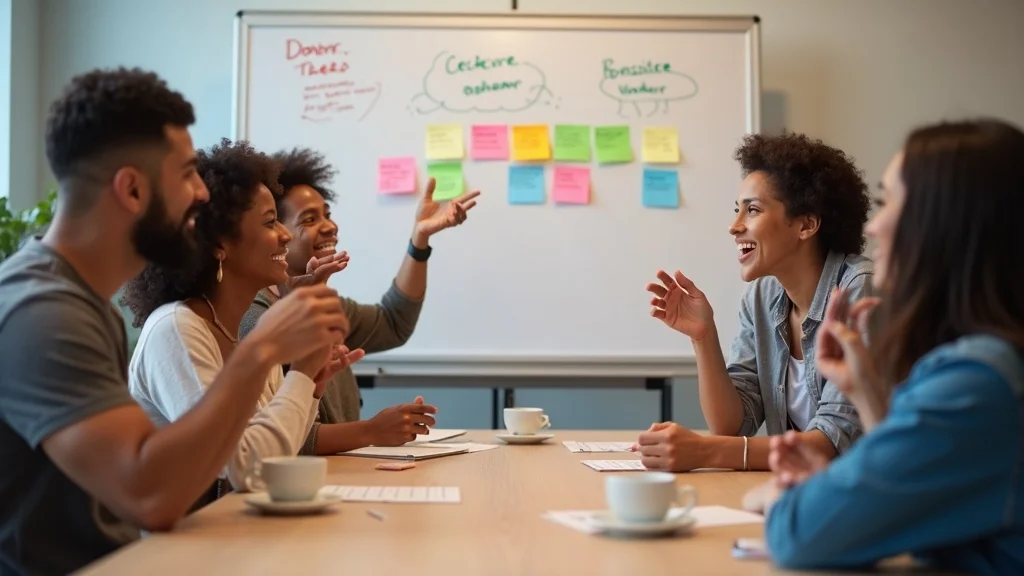Did you know that nonprofits that master effective donor communication experience up to 40% greater donor retention? Unlock the secrets of building deeper donor relationships, boosting donor engagement, and elevating your nonprofit’s success—all by mastering how you talk to your supporters. In this guide, you’ll discover research-backed strategies and practical steps to transform casual contributors into lifelong champions.
The Power of Effective Donor Communication: Uncovering Surprising Facts
"Nonprofits that master effective donor communication experience up to 40% greater donor retention." – Nonprofit Tech for Good
- Only 28% of donors say they feel “truly appreciated” by the organizations they support. (Bloomerang)
- Organizations using a strategic donor communications plan retain 2x more donors year-over-year. (DonorVoice)
- Donors who receive personalized messages have a 50% higher response rate to fundraising appeals.
- Nonprofit communications delivered through multiple channels—email, phone calls, direct mail, and social media—yield the highest engagement rates.
- Segmenting donors by giving history and communication preference increases giving by up to 37%.

What You'll Learn About Effective Donor Communication
- How to build a donor communications strategy from scratch
- How to design a donor communications plan that keeps donors engaged
- Proven communication strategies for nonprofits to personalize and maximize donor relationships
Understanding Effective Donor Communication in Nonprofit Communications
Defining Effective Donor Communication and Its Impact
- Donor engagement: Actively involving donors with your mission through tailored updates, impact stories, and volunteer opportunities.
- Donor relationships: Building trust and connection with supporters to foster loyalty and greater giving.
- Types of donor communications: Emails, phone calls, in-person meetings, direct mail, social media, event invitations, newsletters, and annual reports.
- Communications strategy: Coordinating timing, message, channels, and audience for maximum impact with every touchpoint.
Effective donor communication is the heartbeat of nonprofit success, transforming one-time donors into lifelong supporters. It’s not just about sending updates—it’s about making every group of donors feel valued and vital to your mission. A well-executed communications plan uses a mix of channels (from email newsletters and social media posts to direct mail and phone calls) to keep donors engaged and show them their contributions matter. When you build your communications strategy around donor engagement and appreciation, you make every message a step toward deeper donor relationships.
Why Nonprofit Communications Matter for Donor Engagement
- Strategic donor communications boost retention, so your organization spends less time and resources chasing new donors.
- Frequent, relevant communication nurtures a sense of loyalty and ownership among donors.
- Well-planned nonprofit communications drive measurable impact—from increased event turnout to more major donors participating in planned giving campaigns.
When donors feel informed and appreciated, they're far more likely to stay engaged and increase their contributions over time. An effective donor communication program emphasizes not just asking for funds but also sharing the mission’s achievements, offering regular updates, and celebrating donor impact. This holistic approach ensures that every donor, regardless of giving level, feels seen, heard, and crucial to your cause.
Laying the Foundation: Building a Donor Communications Strategy
Creating a Comprehensive Communications Strategy for Effective Donor Communication
- Assess your current communications: Audit what’s working and where you can improve your touchpoints with donors.
- Set data-driven goals: Use donor data to determine key metrics, such as engagement rates and donor retention.
- Map out your channel mix: Consider emails, direct mail, phone calls, social media, and in-person events to maximize reach.
- Assign responsibilities: Ensure everyone on your nonprofit communications team knows their role in the communications plan.
- Measure results: Regularly review your strategy for effectiveness, donor engagement, and communications plan alignment with your mission.
Building a robust donor communications strategy starts with knowing your audience through thorough analysis of donor data. Defining donor segments, mapping out communication channels, and clarifying the purpose of every message are critical steps. A successful strategies plan keeps your donors engaged, ensures consistency and personalization, and aligns every interaction with both your nonprofit marketing goals and your donors’ expectations.

Setting Measurable Goals for Your Donor Communications Plan
- Increase donor engagement: “Grow email response rates from 15% to 25% among new donors in 6 months.”
- Improve donor retention: “Boost year-over-year donor retention by 10% through regular updates and personalized messages.”
- Enhance major donor relationships: “Schedule quarterly phone calls or in-person check-ins with all major donors.”
- Expand segmentation: “Segment group of donors by giving history and communication preferences to increase planned giving participation by 15%.”
SMART goals—Specific, Measurable, Achievable, Relevant, Time-bound—form the backbone of any effective donor communications plan. By setting clear benchmarks based on donor data, your nonprofit will be able to track progress, demonstrate impact, and make strategic adjustments to keep donors engaged and contributing.
Segmenting Donors for Maximum Engagement and Personalized Communication
Using Donor Data and Donor Database for Segmentation
- Leverage your donor database to track giving history, interests, and engagement touchpoints.
- Segment donors by demographics, donation frequency, and preferred communication channels.
- Use donor data to personalize messages—refer to past gifts, mention relevant projects, and tailor appeals.
- Continuous updating of the donor database ensures your communications plan stays relevant and effective.
The heart of segmenting donors lies in smart use of donor data. A robust donor database allows you to communicate with precision, honoring each supporter’s interests, giving capacity, and history with your organization. This data-driven approach enables tailored outreach—major donors might get phone calls and special stewardship, while new donors receive welcome series emails and event invitations. Segmenting donors through thorough data analysis converts mass messaging into meaningful engagement.

Types of Donor Communication: Matching Communication Strategies to Segments
- Emails: Updates, impact stories, and invitations sent directly to donor inboxes—ideal for monthly touchpoints and campaign launches.
- Phone calls: Personal check-ins, stewardship, or major gift solicitations that build high-touch relationships.
- Events: In-person or virtual events provide unique opportunities for cultivating loyalty and celebrating donors.
- Newsletters: Regular updates via email or print to keep donors engaged and connected to your nonprofit’s mission.
- Annual reports: Comprehensive highlights of the impact, financial stewardship, and gratitude for donor support.
- Social media: Real-time engagement and broader outreach, highlighting donor impact and current campaigns.
- Direct mail: Highly personalized solicitations, thank-you notes, and newsletters for a tactile donor experience.
Each donor communication channel serves a distinct purpose and audience. By matching your communication strategies to each segment, you ensure every donor receives the information and appreciation that resonates most with their giving style and communication preferences.
Developing an Effective Donor Communications Plan
Essential Elements of a Donor Communications Plan
- Channel mix: Combining digital (email, social media) and traditional (phone calls, direct mail) communication tactics for comprehensive reach
- Cadence: Setting a consistent and appropriate frequency for outreach—e.g., monthly emails, quarterly newsletters, annual stewardship calls
- Message mapping: Aligning messages to donor segments, giving level, and communication preferences
- Donor appreciation: Including intentional touchpoints for gratitude, such as thank-you notes or donor spotlights
- Responsibility: Assigning point persons for each communication channel within your communications strategy
The most effective donor communications plan is clear, actionable, and easy for your team to follow. With a mix of personalized messages, regular updates, and intentional gratitude, your nonprofit communications can keep donors engaged across every stage of their donor journey.
Table: Donor Communications Plan Template
| Communication Channel | Purpose | Audience Segment | Frequency | Responsible Party |
|---|---|---|---|---|
| Email Newsletter | Share impact stories, updates | All donors | Monthly | Communications Manager |
| Phone Call | Stewardship, major donor updates | Major donors, loyal supporters | Quarterly | Executive Director |
| Social Media | Highlight donor impact, events | General public, donors | Weekly | Marketing Coordinator |
| Direct Mail | Solicitations, annual report | Long-term and older donors | Annually | Development Officer |
| Thank-You Note | Donor appreciation | All donors after gifts | Within 48 hours | Donor Relations Officer |
Crafting Compelling Messages: Key Donor Communication Strategies
Elevating Impact with Storytelling in Donor Communications
- Use real stories from program recipients to highlight donor impact and bring your mission to life.
- Express gratitude: Clearly acknowledge and thank donors for their specific support.
- Show results: Demonstrate the difference each gift made via photos, videos, and statistics in your nonprofit communications.
- Create a sense of belonging: Make donors feel like an essential part of your nonprofit’s success story.
Nothing resonates more than authentic stories spotlighting how donor gifts change lives. Share first-person narratives, heartfelt testimonials, and inspiring updates in your donor communication to foster connections. By weaving a narrative that links donor involvement—no matter their gift size—to tangible results, you build trust, foster ongoing donor engagement, and position your nonprofit as a transparent and impactful organization.

Writing for Different Channels in Your Communications Plan
- Emails: Keep it concise, visual, and actionable—embed donor stories and clear calls-to-action.
- Phone calls: Use scripts that highlight donor appreciation and allow space for donor feedback or questions.
- Events: Incorporate personal recognition, such as donor spotlights or thank-you speeches.
- Direct mail: Use high-quality materials and tailored messages for key segments, like major donors or planned giving prospects.
Each communication channel invites a unique style. Effective donor communication means adapting your voice and approach to match the medium—friendly subject lines in emails, warm and engaging tone in phone calls, and polished messaging in direct mail pieces. By mapping your messaging to the donor’s preferred channel, you ensure your communications strategy builds trust and keeps your donors engaged.
Quote: Real-World Success with Effective Donor Communication
"Since implementing a multichannel donor communications strategy, we’ve doubled donor engagement in six months."
– Executive Director, Urban Hope Fund
Watch how a modern nonprofit team reaches donors: staff send personalized emails, make thoughtful phone calls, host donor appreciation events, and connect through vibrant social media posts—each channel amplifying the impact of their donor communications strategy.
Ensuring Donor Appreciation Throughout Your Donor Communications Plan
Ways to Show Donor Appreciation and Foster Meaningful Donor Relationships
- Handwritten personal notes after every contribution
- Exclusive recognition events, both virtual and in-person
- Donor walls spotlighting committed supporters
- Phone calls of thanks from leadership or staff
Making donors feel genuinely appreciated is the linchpin of long-term donor engagement and retention. Every touch, whether a personal note or a phone call, signals that each donor matters.
Using Phone Calls for High-Impact Donor Engagement
- Phone calls are best for major donors, repeat supporters, and milestone recognitions.
- Use phone calls to share exciting results or personally thank donors who made special gifts.
- Keep the tone authentic—listen as much as you speak, and follow up with tailored impact updates.
A well-timed phone call can transform a transactional relationship into a lifelong partnership. These calls should be prioritized after major campaigns, first-time gifts, or anniversaries of giving. When donors hear a sincere thank-you directly from your team, it often opens the door for deeper engagement and future giving.

See real-world donor communications in action—personal phone calls, engaging event moments, and heartfelt thank-you notes that make every donor feel like a VIP.
Best Practices and Pitfalls: Enhancing Your Donor Communications Strategy
Communication Strategies to Keep Donors Engaged
- Personalize every touchpoint using your donor database
- Maintain regular outreach—balance frequency to keep donors engaged without overwhelming them
- Be transparent—share not only successes but also lessons learned and challenges
- Encourage two-way communication by inviting feedback and questions
The most effective donor communications strategy finds the sweet spot between regular updates and relevant content, always tailoring messages using donor data. A focus on donor appreciation, transparency, and feedback ensures donors remain connected and loyal.
Common Mistakes in Donor Communication and How to Avoid Them
- Delayed or untimely responses—donors expect quick acknowledgments and follow-up
- Generic messaging—personalization is key; avoid mass emails with no recipient name or historical context
- Neglecting donor appreciation—don’t let gratitude be an afterthought; make it part of your communications plan
- Ignoring segmentation—treating all donors the same can alienate your best supporters
Pitfalls like lack of personalization or ignoring timely communication can undermine even the best donor relationships. By integrating donor segmentation, appreciation, and strategic follow-up into your communications plan, you set your nonprofit up for long-term donor retention and support.

People Also Ask: Effective Donor Communication FAQs
How can I improve donor communication for my nonprofit?
- Build a segmented donor communications strategy based on giving history and interests.
- Draft a clear donor communications plan covering all major communication channels.
- Regularly show donor appreciation through personalized notes, recognition, and phone calls.
Improving donor communication starts with understanding your supporters and implementing a tailored communications plan using best practices for donor engagement and appreciation.
What is a donor communications plan, and why is it important?
- A donor communications plan is a structured framework guiding how you communicate with donors, using the right channels, frequency, and messages.
- It’s essential for boosting donor engagement and retention by ensuring consistent, meaningful communication that strengthens relationships and trust.
A strategic communications plan empowers nonprofits to deliver timely, effective donor communication that keeps donors engaged, informed, and motivated to support your mission.
Which communication channels are most effective for engaging donors?
- Email: For broad outreach and storytelling
- Phone calls: For personalized stewardship and major donor engagement
- In-person meetings and special events: For building lasting relationships
- Social media: For rapid, ongoing engagement and awareness-building
- Newsletters and direct mail: For tangible, memorable updates and appeals
The best communication strategies use a combination of channels, with messages tailored to each donor’s preferences and relationship stage.
How often should I contact donors to keep them engaged?
- Create a communications plan with regular, meaningful touchpoints (e.g., monthly emails, quarterly phone calls, annual impact reports).
- Strike a balance—enough outreach to keep donors informed and appreciated, without overwhelming them.
Donor engagement thrives with planned, consistent communication; set a rhythm that fits your supporters and adjust based on their feedback.
Key Takeaways: Mastering Effective Donor Communication
- Effective donor communication increases retention, loyalty, and overall fundraising success.
- A thoughtful communications strategy with measurable goals and channel mix is essential for keeping donors engaged.
- Personalization, regular updates, and genuine appreciation are the cornerstones of any successful donor communications plan.
- Continually refine your plan using donor data for improved engagement and support.
Get Personalized Advice on Effective Donor Communication
- Ready to skyrocket your impact? Call me the Chaplain 786-333-5270 for tailored donor communications guidance.
Conclusion: Mastering effective donor communication is your nonprofit’s gateway to lasting support, strong donor relationships, and record-breaking donor engagement. Start building your winning communications plan today!
To deepen your understanding of effective donor communication, consider exploring the following resources:
-
“3 Keys to Effective Donor Communications” (bwf.com) offers insights into targeting your audience, storytelling, and utilizing multiple communication platforms to enhance donor engagement.
-
“The Art of Donor Communications: Writing for Impact” (nonprofit.team) provides strategies for crafting compelling messages that make donors feel appreciated and connected to your mission.
These resources will equip you with practical strategies to enhance your donor communication efforts and strengthen your organization’s relationships with its supporters.
 Add Row
Add Row  Add
Add 




Write A Comment